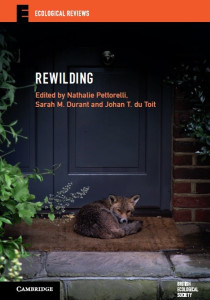 Last week was the first post in our joint blog series with The Applied Ecologist’s Blog, celebrating the release of the latest Ecological Reviews, Rewilding. In this post Nathalie Pettorelli (Zoological Society of London) introduced the challenging concept of reaching a consensus when it comes to rewilding. Catch up with that if you missed it here.
Last week was the first post in our joint blog series with The Applied Ecologist’s Blog, celebrating the release of the latest Ecological Reviews, Rewilding. In this post Nathalie Pettorelli (Zoological Society of London) introduced the challenging concept of reaching a consensus when it comes to rewilding. Catch up with that if you missed it here.
Our second post is from author Dr Kim Ward, Lecturer in Human Geography at the University of Plymouth. Here she explains the necessity of rewilding conceptually being tied to a relational framework, in order to avoid resorting to outdated Colonial views of Nature-Culture dualism.
Whilst rewilding has emerged as a popular and controversial conservation strategy in recent years it has been lambasted by some critics for advocating ‘wilderness’ preservation, and for it’s supposed preference of re-wilding ‘back’ to a particular type of nature. Both ‘wilderness’ and ‘going back’, critics argue, are bound-up in a drive to create a ‘pristine’ nature, a nature before human inhabitation. Wilderness, in these narratives, is framed as a pristine, uninhabited and/or uninhabitable space, separate and autonomous from human thought.
This conceptual position is commonly referred to as Nature-Culture dualism, where human beings are considered to be external to nature. Whilst defenders of wilderness have historically hit back at such critiques as a ‘war against nature’ it is important to acknowledge that wilderness, whilst a seemingly innocent and objective material reality, is a concept indelible with symbolic meaning. In Western environmental narratives at least, the ‘wilderness idea’ was led by Euro-American men within the historical context of patriarchal colonialism and wilderness preservation is therefore, an artefact of colonialism that can (and has) act as a vehicle for the exclusion and erasure of indigenous people and their histories from the land.
To ensure that we do not to fall back into this colonialist trap it is important that we distinguish rewilding as a dynamic process creating ‘wildness’, rather than one that creates or protects ‘wilderness’. On a conceptual level one way to prevent conflation of the two terms is by understanding (and practicing!) rewilding in a relational, rather than binary sense. What does this mean? In relational understandings of what nature is, Nature and Culture are understood to be intricately connected. Humans are not separate from, but intrinsic to, their environments. In reality practitioners already recognize that the simplicity of binary thinking does not adequately capture the complexity of present day ecosystems and the dynamic processes that bring them into being. Indeed complexity theory has highlighted the variability and unpredictability of living systems and many ecologists would argue that making recourse to past so-called ‘pristine’ landscapes makes little sense when the majority of flora and fauna, at least in urban Europe, are part of highly altered ecological systems.
Hence by conceptually underpinning rewilding with a relational framework we find a way to acknowledge the complex human-no human networks, histories and ecologies within which wildness can emerge. Importantly, by proposing that rewilding should conceptually be tied to a relational framework we acknowledge that the emergence of wildness does not rely on ‘nature’ being separate from humans, but that humans and non-humans can co-produce wild landscapes together if both are given a degree of autonomy of their environment.
Kim is on twitter @kimjadeward
Read more in our rewilding series:
Getting everyone on board with rewilding by Nathalie Pettorelli
Trophic rewilding: restoring top-down food web processes to promote self-managing ecosystems by Jens-Christian Svenning